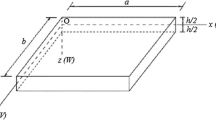Abstract
In the present paper, the extended finite element method (X-FEM) is adopted to analyze vibrations of cracked plates. Mindlin’s plate theory taking into account the effects of shear deformation and rotatory inertia is included in the development of the model. First, conventional FEM without any discontinuity is carried out, then the enrichment proposed by Moës et al. (Int J Numer Methods Eng 46, 131–150, 1999) of nodal elements containing cracks is added to the FEM formulation. Numerical implementation of enriched elements by discontinuous functions is performed, and thus dynamic equations (stiffness and mass matrices) are established. A FORTRAN computer code based on the X-FEM formulation is hence developed. Rectangular and square plates containing through-edge and central cracks with different boundary conditions are considered. The subspace iteration method is used to solve the eigenvalue problem. Natural frequencies as well as the corresponding eigenfunctions are consequently calculated as a function of the crack length. The obtained results show that the X-FEM is an efficient method in the dynamic analysis of plates containing discontinuities.
Similar content being viewed by others
References
Ali, R., Atwai, S.J.: Prediction of natural frequencies of vibration of rectangular plates with rectangular cutouts. Comput. Struct. 12, 819–826 (1980)
Bachene, M., Tiberkak, R., Rechak, S., Hachi, B.E.K.: Analyse du comportement vibratoire des plaques fissurées par la X-FEM. In: 18th French Congress on Mechanics, Grenoble, France (2007)
Bathe, K.J., Wilson, E.L.: Finite element procedures. Prentice Hall, Englewood Cliffs (1996)
Belytschko, T., Black, T.: Elastic crack growth in finite elements with minimal remeshing. Int. J. Numer. Methods. Eng. 45(5), 601–620 (1999)
Belytschko, T., Moës, N., Usui, S., Parimi, C.: Arbitrary discontinuities in finite elements. Int. J. Numer. Methods. Eng. 50, 993–1013 (2001)
Cawley, P., Adams, R.D.: The location of defects in structures from measurements of natural frequencies. J. Strain Anal. 14, 49–57 (1979)
Dolbow, J., Möes, N., Belytschko, T.: Modeling fracture in Mindlin–Reissner plates with the extended finite element method. Int. J. Solids Struct. 37(48–50), 7161–7183 (2000)
Fujimoto, T., Sumi, S.: Vibration characteristics of center cracked plates under tension. Bull. Jpn. Soc. Mech. Eng. 53, 1124–1131 (1987)
Khadem, S.E., Rezaee, M.: Introduction of modified comparison functions for vibration analysis of a rectangular cracked plate. J. Sound Vibr. 236(2), 245–58 (2000)
Krawczuk, M.: Natural vibration of rectangular plates with a through crack. Arch. Appl. Mech. 63, 491–504 (1993)
Krawczuk, M., Ostachowicz, W.M.: A finite plate element for dynamic analysis of a cracked plate. Comput. Methods Appl. Mech. Eng. 115, 67–78 (1993)
Lee, H.P., Lim, S.P.: Vibration of cracked rectangular plates including transverse shear deformation and rotary inertia. Comput. Struct. 49(4), 715–718 (1993)
Liew, K.M., Hung, K.C., Lim, M.K.: A solution method for analysis of cracked plates under vibration. Eng. Fract. Mech. 48(3), 393–404 (1994)
Lynn, P.P., Kumbasar, N.: Free vibration of thin rectangular plates having narrow cracks with simply supported edges. In: Proceedings of the 10th Midwestern Mechanics Conference, Colorado State University, Fort Collins Co., pp. 911–928 (1967)
Melenk, J.M., Babuska, I.: The partition of unity finite element method, basic theory and applications. Comput. Methods Appl. Mech. Eng. 39, 289–314 (1996)
Moës, N., Dolbow, J., Belytschko, T.: A finite element method for crack growth without remeshing. Int. J. Numer. Methods Eng. 46, 131–150 (1999)
Qian, G.L., Gu, S.N., Jiang, J.S.: A finite element model of cracked plates and application to vibration problems. Comput. Struct. 39(5), 483–487 (1991)
Solecki, R.: Bending vibration of a simply supported rectangular plate with a crack parallel to one edge. Eng. Fract. Mech. 18(6), 1111–1118 (1983)
Stahl, B., Keer, L.M.: Vibration and stability of cracked rectangular plates. Int. J. Solids Struct. 8, 69–92 (1972)
Wu, G.Y., Shih, Y.S.: Dynamic instability of rectangular plate with an edge crack. Comput. Struct. 84(1–2), 1–10 (2005)
Zienkiewicz, O.C., Taylor, R.: The Finite Element Method, vols. 1 and 2. Butterworth (2000)
Author information
Authors and Affiliations
Corresponding author
Rights and permissions
About this article
Cite this article
Bachene, M., Tiberkak, R. & Rechak, S. Vibration analysis of cracked plates using the extended finite element method. Arch Appl Mech 79, 249–262 (2009). https://doi.org/10.1007/s00419-008-0224-7
Received:
Accepted:
Published:
Issue Date:
DOI: https://doi.org/10.1007/s00419-008-0224-7




